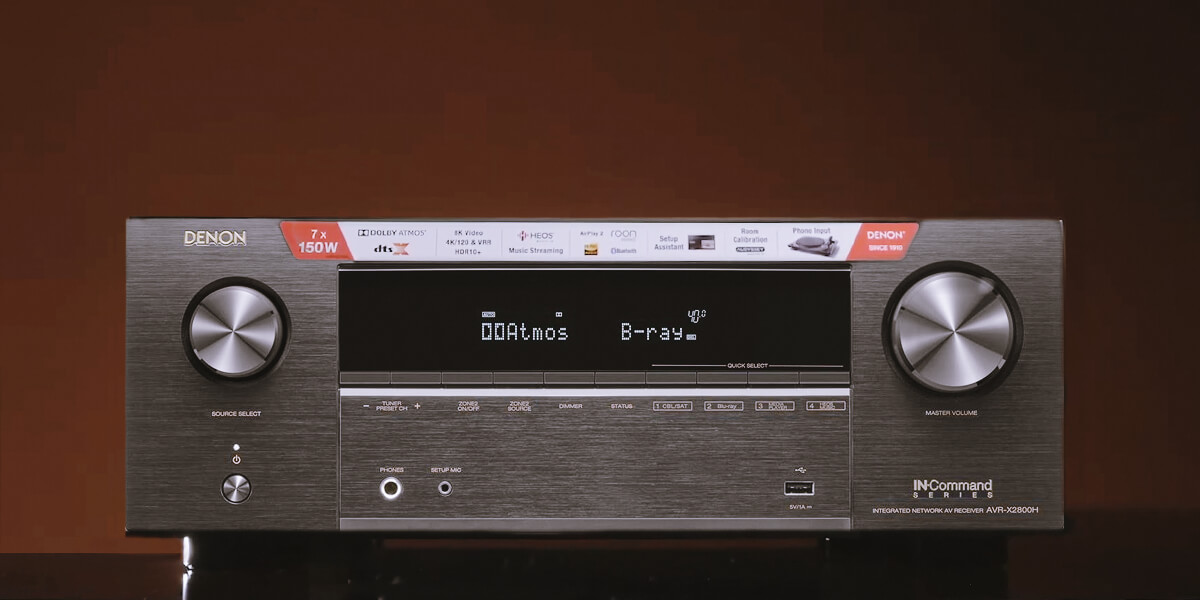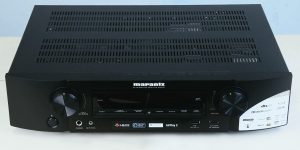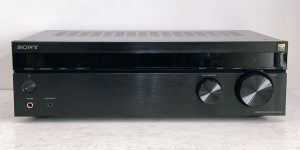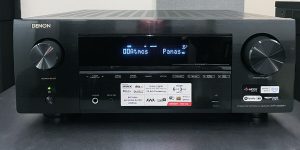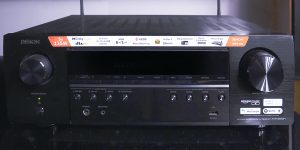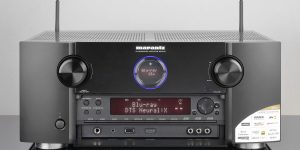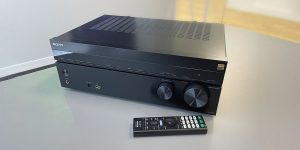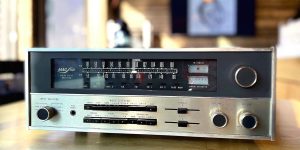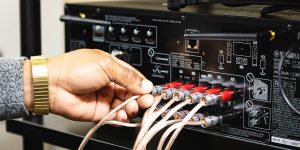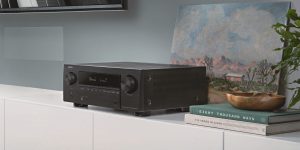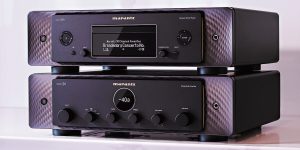The 7.1 configuration is by far the most popular and in demand for people who want a home theater system with good features and at a reasonable price. In particular, such popularity of 7.1 systems is due to Dolby Atmos technology, which implies suspended speakers. Such receivers allow, albeit in a minimal configuration, to plunge into surround sound and the latest technology. So I decided to offer you my selection of the best 7.2 receivers, featuring five models from different manufacturers at different price points and their capabilities. Each of these receivers can be a worthy addition to your home and give an experience in different areas, whether a music or movie night. But first, let’s look at what the 7 channels offer.
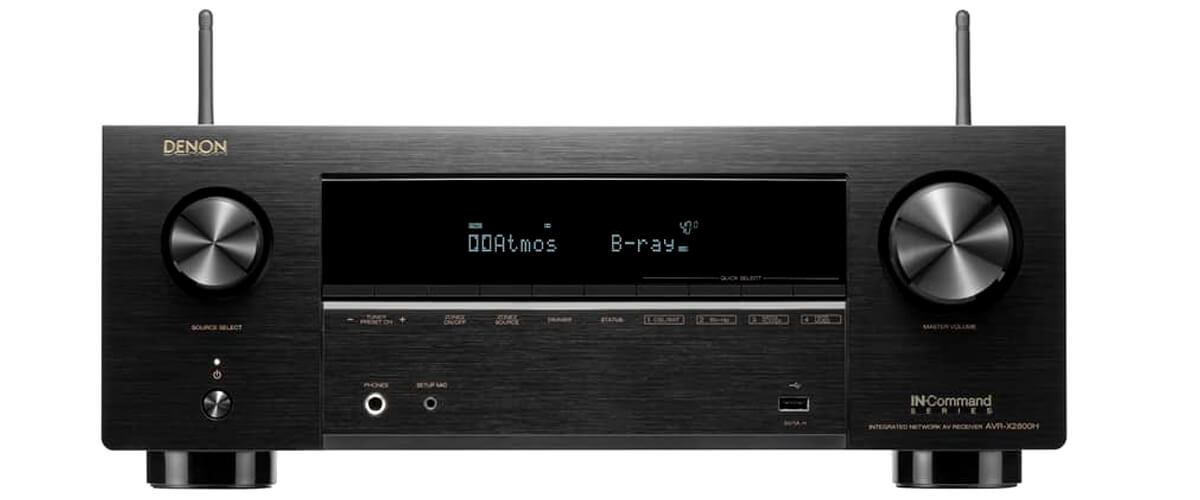
7.2 AV receivers comparison table
| Name | Channels | Power output | HDMI in/out | Bluetooth/Wi-Fi | Review |
|---|---|---|---|---|---|
| Denon AVR-X2800H best overall | 7.2 | 95W/8 Ohm, 125W/6 Ohm | 6/2 | yes/yes | Review |
| Marantz SR5015 also great | 7.2 | 100W/8 Ohm, 140W/6 Ohm | 6/2 | yes/yes | Review |
| Sony STR-DH790 budget | 7.2 | 90W/6 Ohm | 4/1 | yes/no | Review |
What is a 7-channel home theater system?
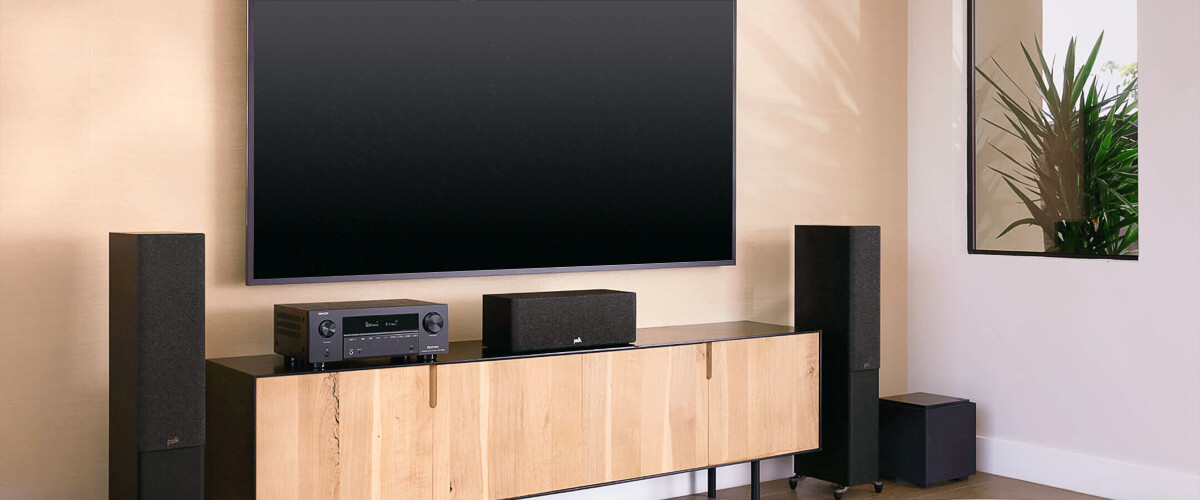
In essence, each successive system is an improvement, an expansion of the previous one. That is, the 7.1 receiver is the same 5.1 channel system but with the addition of two overhead speakers. The home theater setup thus includes the installation of the following:
- front right and left speakers for stereo sound (positioned on the sides of the screen);
- center speaker for dialog (usually below the screen);
- surround sound speakers for additional effects (mounted on the sides of the audience at ear level).
Finally, the left and right rear speakers provide more surround sound (positioned behind the audience or under the ceiling if you create a 5.2.1 configuration, where “2” is the ceiling speakers).
Such a system sounds more voluminous than a 5-channel system. And 7-channel receivers decode the Dolby Atmos and DTS:X surround sound formats, the most popular today. They create an atmosphere of immersion in the action on the screen, making the sound more realistic and more saturated.
I will also draw your attention to the number “1” in the name of the 7.1 system. It stands for the subwoofer, which is responsible for the bass. And if there is a number “2”, it means the addition of an additional subwoofer for more dynamics.
Advantages of 7.2 channel systems
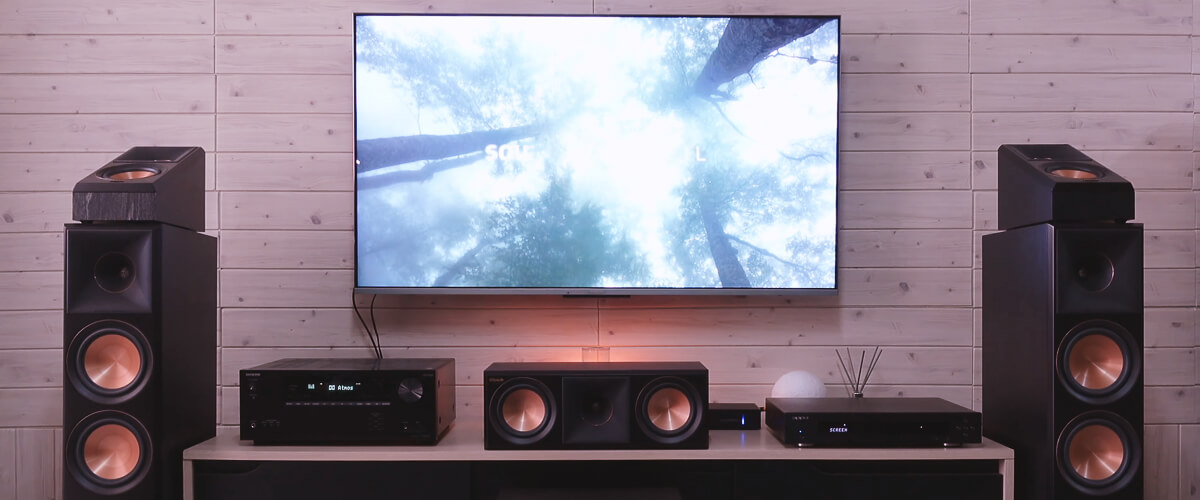
The advantage of this system is the improved bass response. With two subwoofers instead of one, a 7.2 surround sound system provides a more balanced and even bass distribution throughout the room. As a result, you will avoid so-called “dead zones” or excessive bass boost in certain areas. The overall sound composition will be brighter and richer accordingly.
Best 7.2 receiver reviews
Denon AVR-X2800H – best overall

Apparently, considering the popularity of the previous Denon AVR-X2700H version, in 2022, the company decided to repeat its success with the new Denon AVR-X2800H model, which opens my chart and is essentially an upgrade of the previous version. Admittedly, it’s the most expensive representative, but Denon is always about guaranteed quality and versatility, especially regarding the mid-range segment.
So, this 7.2-channel receiver has 95W of power (8 Ohms, 20Hz – 20kHz, 0.08%, 2ch) and supports Dolby Atmos or DTS:X surround sound formats. But that won’t set it apart from other models since my selection consists of more or less similar AV receivers. But suppose you don’t want to put in overhead speakers. In that case, you might be pleased to find support for DTS Virtual:X and Dolby Atmos Height Virtualization technology to build a 7.2 rather than 5.2.2 configuration.
Regarding video features, the AVR-X2800H is also a modern advanced device, as its HDMI 2.1 ports (6 inputs with HDCP2.3 and 2 outputs with eARC) support 8K/60Hz or 4K/120Hz resolution and HDR10, HDR10+, Dolby Vision and HLG formats. As more and more content is released in the highest quality today, these options allow you to avoid upgrading your system for a long time. And even existing content with a worse resolution you can improve through upscaling technology to 8K. And I especially appreciate the HDMI port on the front panel, as it is very convenient when the number of ports is limited, and you often have to connect equipment one by one without constantly turning the receiver around.
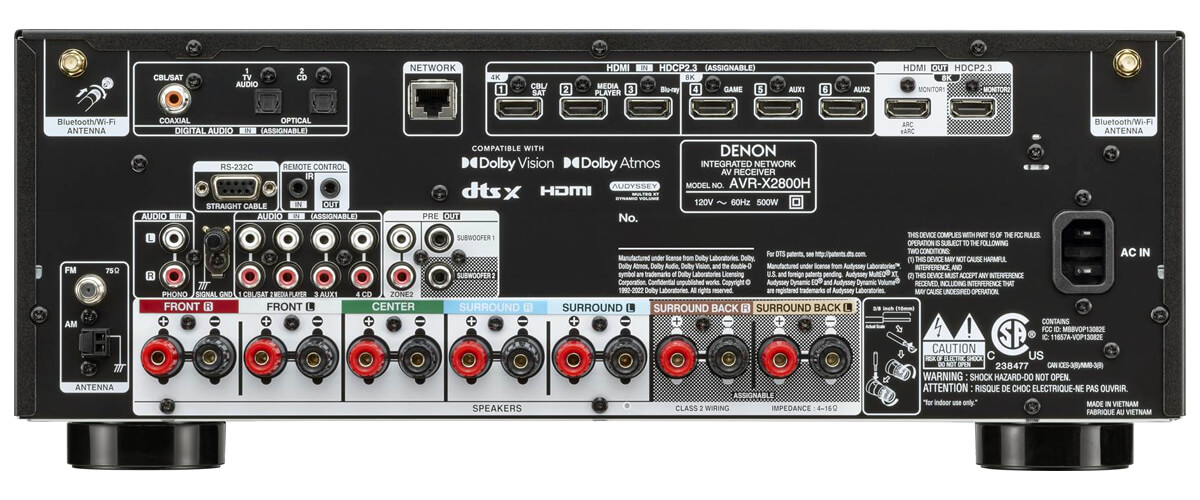
Of the extras that make the Denon AVR-X2800H the leader of my rating, there are multiple jacks for older equipment, a player with a MM cartridge, bi-amping, multi-room audio, and video streaming to 2 Zones. Dual-band Wi-Fi allows the built-in HEOS system for wireless streaming throughout the house, works with Android and Apple, Hey Google, and Amazon Alexa voice assistants, and music streaming is possible with all available streaming services, including Roon Tested for true audiophiles. It can also be used for audio, video, and multi-room audio. Bluetooth, of course, is also available. Honestly, it rivals some of the more expensive models in its capabilities. But it’s a shame that the system can’t be expanded to 9 channels over time.
Another distinctive feature is that the headphones can be used simultaneously as the speakers. It is great if you have a hard-of-hearing person in the family. I recommend paying attention to such a bonus.
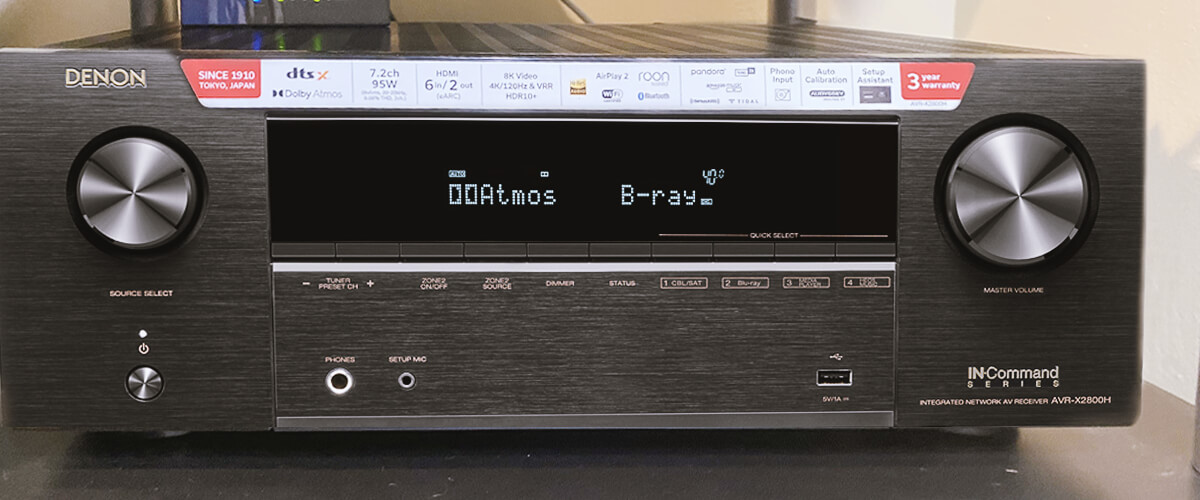
Denon is, as always, easy to set up, but you’ll need to fiddle with the equalizer a bit to get it to perfection. But only by time, and only if you are a meticulous user like me. But I adore Denon’s warm, realistic sound, so I first tried the vinyl player with Saturday Night Fever, Bee Gees. This company knows a lot about analog sound; I’m thrilled with the fat bass and overall stereo composition, where you hear every detail as if you were in the studio. The surround sound also pleased me with its warmth and richness. I watched different movies with different sound rows, and I really, really liked everything.
The Denon AVR-X2800H is the best 7.2 receiver overall. It has state-of-the-art video and audio support among competitors, including surround sound. This AVR is a versatile device for people who love music, games, and movies while offering advanced system optimization options at this level.
Key specs
- Channels: 7.2.
- Power output: 95W/8 Ohm, 125W/6 Ohm.
- HDMI inputs/outputs: 6/2.
- Video functions: 8K/60Hz, 4K/120Hz pass-through, upscaling to 8K.
- Bluetooth/Wi-Fi: yes/yes.
- Streaming services: AirPlay 2, Spotify, TuneIn, Deezer, Tidal, Netflix, Amazon Prime.
- Supports: HDMI ARC, HDMI eARC, HDMI CEC, HDCP2.3, HDR10+, HLG, Dolby Vision.
- Surround sound: DTS:X, DTS Neural:X, DTS Virtual:X, Dolby Atmos, Dolby Atmos Height Virtualization, DTS HD Master, Dolby TrueHD, Multichannel Stereo.
Pros
- 3D audio virtualization options will suit those who don’t want to place overhead speakers.
- The presence of an HDMI port on the front makes it easy to access and replace connected equipment.
- Headphones can be used simultaneously as speakers, allowing people with impaired hearing to participate in family viewing.
- Works with Roon Tested.
Cons
- I didn’t find any flaws during my testing.
Marantz SR5015 – also great
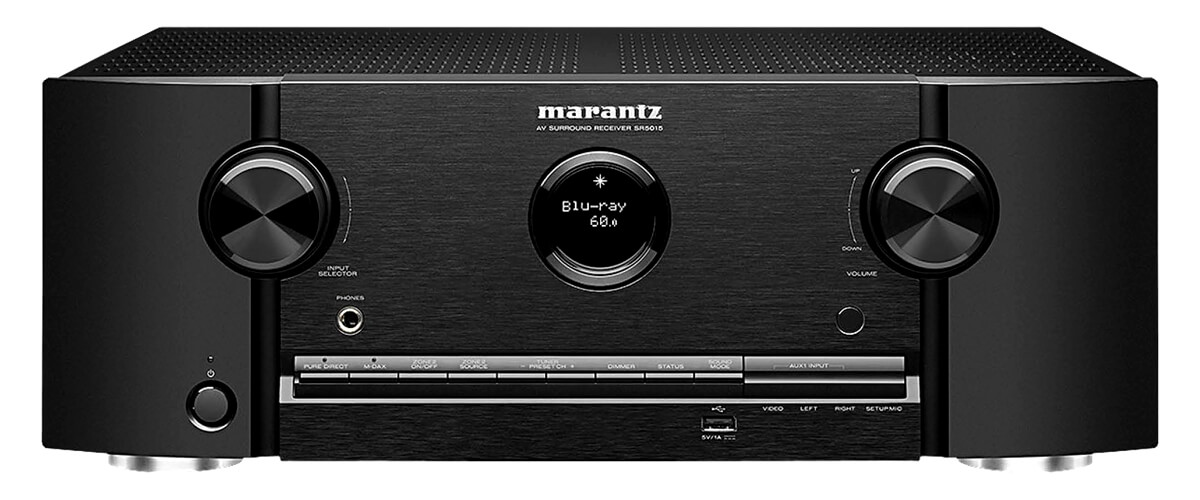
I will not write much about this model because the Marantz SR5015 resembles the Denon AVR-X2800H, almost like a twin. Although its price is quite a bit lower, I do not put Marantz in the first place for several reasons, and I will tell you about them.
First of all, the design of the receiver, which its fans appreciate so much, is worth mentioning. The SR5015 is indeed a replica of the more expensive members of the brand, and it looks premium. But I’m not a fan of the little round LCD that doesn’t show anything from afar, and it’s just useless. Nevertheless, it’s a matter of pure taste.
The receiver offers more power at 100W per channel (8 Ohms, 20Hz – 20kHz, 0.08% THD, 2 ch), but I don’t consider it an advantage because I don’t recommend cranking up the volume to the max in medium-segment equipment in any way. Given the THD rating, this is not the right decision. You’re bound to start hearing interference. So the 5W difference just doesn’t matter.
As I mentioned earlier, its features are exactly the same as the Denon AVR-X2800H. It supports Dolby Atmos and DTS:X surround sound formats and virtual versions for those who don’t want to put speakers in the ceiling. It also has 6 HDMI 2.1 inputs and 2 HDMI 2.1 outputs with HDCP2.3 and eARC support. It also has good gaming options (ALLM, VRR) at 4K/60Hz and broadcasts HDR10, HDR10+, Dolby Vision, and HLG video at 8K/60Hz and 4K/120Hz with upscaling capabilities.
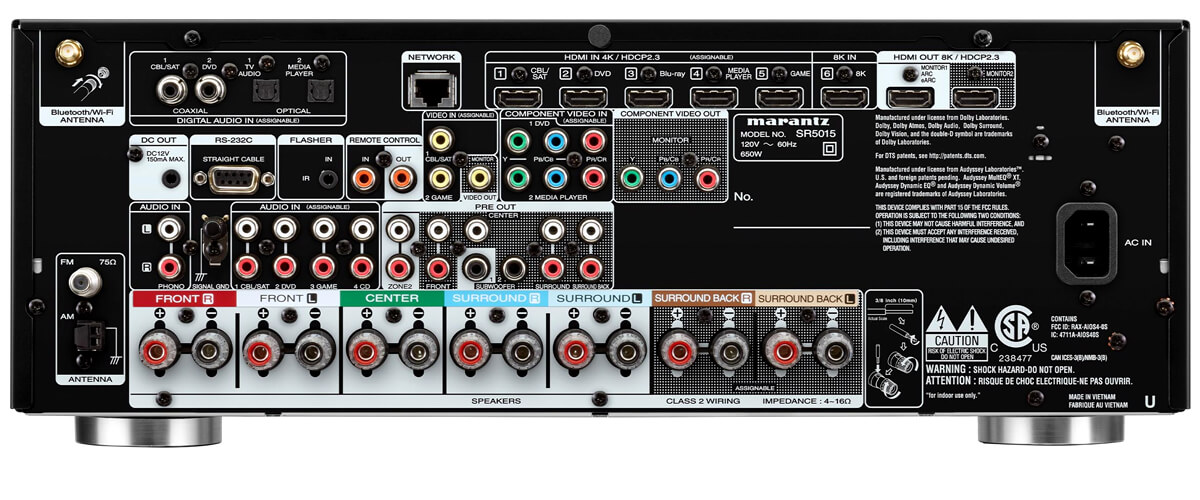
The wired and wireless connectivity are also identical, down to the built-in HEOS ecosystem, which Marantz uses a lot in its equipment, although Denon developed it. And it also works with streaming services (including Roon Tested) and voice assistants and is compatible with Android and iOs.
“What’s the catch?” you ask, “since the Marantz is usually more expensive than any other model in its category?” I can only speculate based on my experience, but it seems to me that the manufacturer has saved money on components. During operation, the receiver overheated and shut down. It took me several hours to turn it back on. If you don’t overload it, I am sure it will be more or less stable; at least it hasn’t lagged again. However, there are many complaints about frequent defects of this model. It further proves my doubts about the quality of the internal electronics.
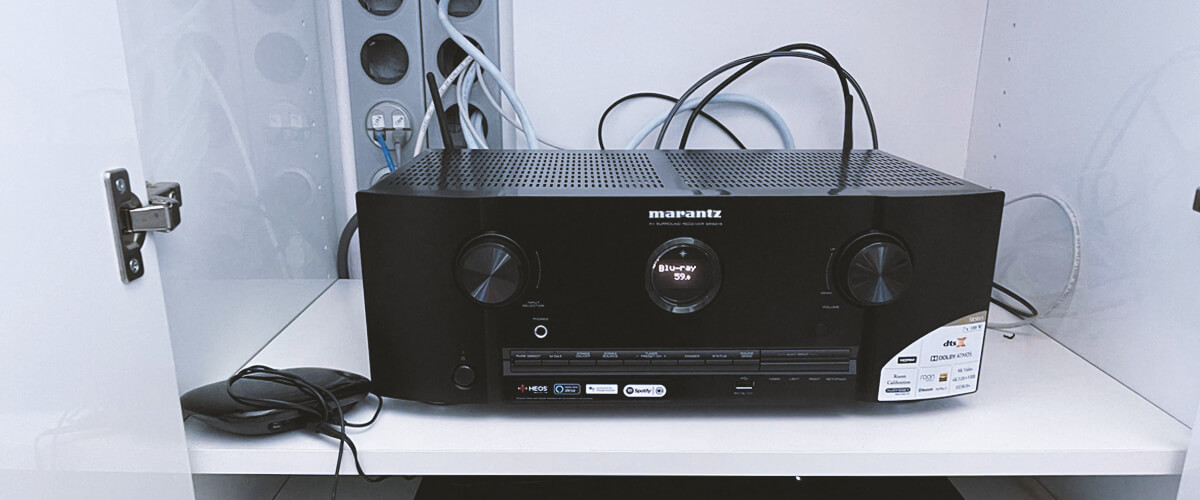
Nevertheless, the Marantz SR5015 has a simple setup and great sound. While using wireless Internet radio, I was pleasantly impressed with how it handled different genres, seemingly adapting to each one, bringing out the bright nuances and vocals. Dolby Atmos surround sound virtualization didn’t impress me to the point of creepiness but satisfied me with signal quality. Anyway, I wasn’t expecting something stunning from a 7-channel system as with more advanced home theater systems.
The Marantz SR5015 could be the best 7.2 AV receiver on my list if the manufacturer paid attention to quality design and internal components because it is a versatile device that considers all user needs today. Nevertheless, I recommend it to those who want to own a Marantz for a reasonable price.
Key specs
- Channels: 7.2.
- Power output: 100W/8 Ohm, 140W/6Ohm.
- HDMI inputs/outputs: 6/2.
- Video functions: 8K/60Hz, 4K/120Hz pass-through, upscaling to 8K.
- Bluetooth/Wi-Fi: yes/yes.
- Streaming services: AirPlay 2, Spotify, TuneIn, Deezer, Tidal, Netflix, Amazon Prime.
- Supports: HDMI ARC, HDMI eARC, HDMI CEC, HDCP2.3, HDR10+, Dolby Vision.
- Surround sound: DTS:X, DTS Virtual:X, Dolby Atmos, DTS HD Master, Dolby TrueHD.
Pros
- Excellent sound quality for a reasonable price.
- Support for the latest video, audio formats, and the most popular 3D sound formats.
Cons
- Uncomfortable unviewable LCD.
- During testing, the receiver overheated and did not turn on for several hours.
Sony STR-DH790 – budget
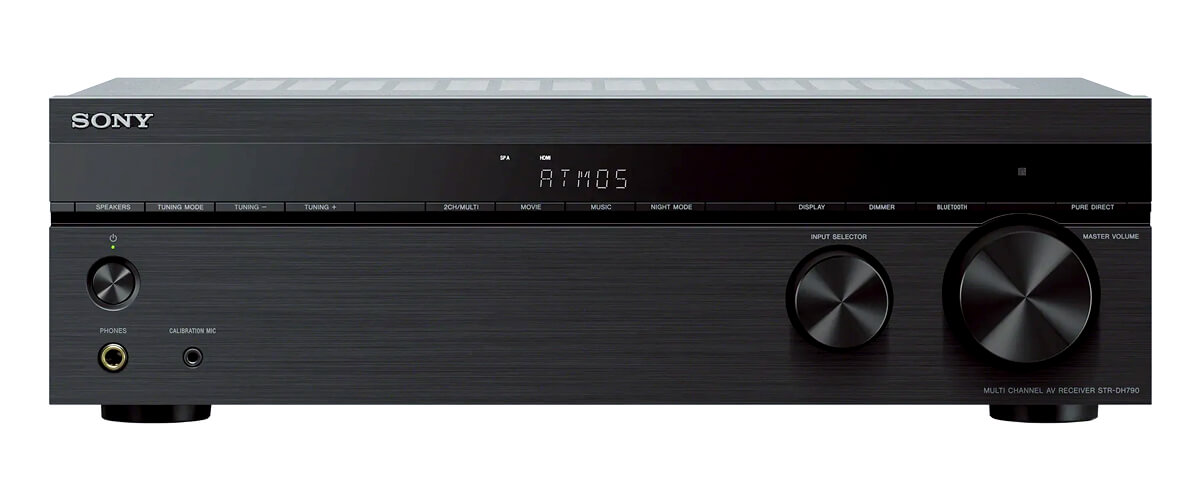
We got to the budget model on my list, the 2018 Sony STR-DH790. Of course, it is inferior to its predecessors, but it has decent qualities and an extremely attractive price.
The manufacturer declares a power of 145W (6 Ohm, 1kHz, THD 0.9%, 1 ch) and compatibility with speakers with impedance from 6 to 16 Ohm. Which means you won’t have to replace your speakers.
It also supports the latest Dolby Atmos and DTS:X surround formats but cannot virtualize them. So unless you want to drill into the ceiling, you’ll have to settle for the older surround sound formats that the STR-DH790 supports.
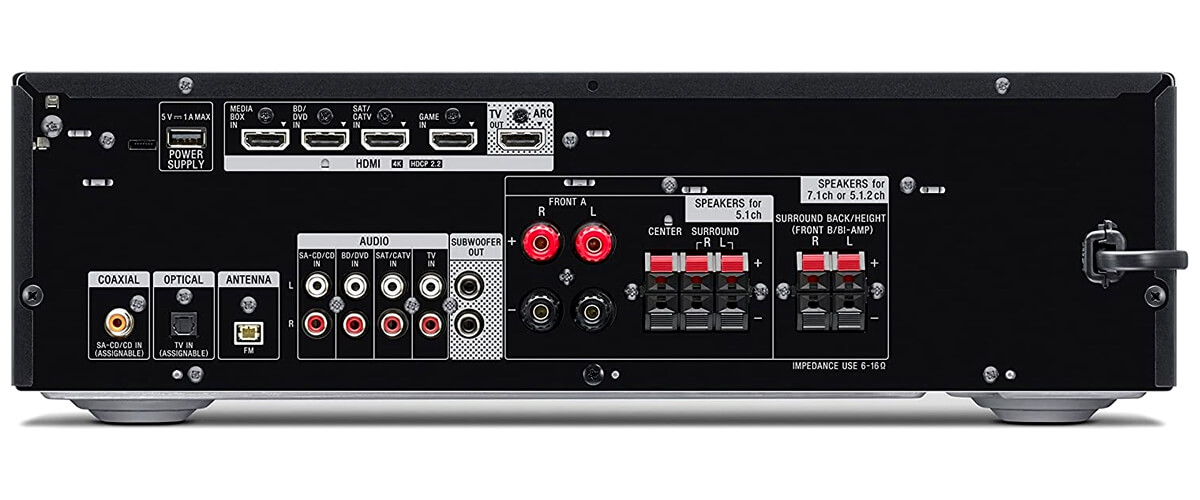
It also has fewer HDMI ports (4/1) with HDCP 2.2 and eARC support, which will reduce your connectivity options. Plus, it only supports 4K/60Hz video and doesn’t support HDR10+ format, although it does have other versions of HDR. Also, its USB port is only for charging devices. So, as you can see, compared to the same Denon AVR-X2800H, there are a lot of compromises, but they are not significant if you are looking for a modern device at a low price.
At the same time, I can’t help but draw your attention to the built-in virtual surround sound technology S-Force PRO will solve the surround sound problem even if you only have two front speakers. And that’s a big plus.
The Sony STR-DH790 also has some jacks for older equipment and Bluetooth wireless connectivity. There’s no Wi-Fi, though. And you can only connect a record player via analog inputs and with an external preamp.
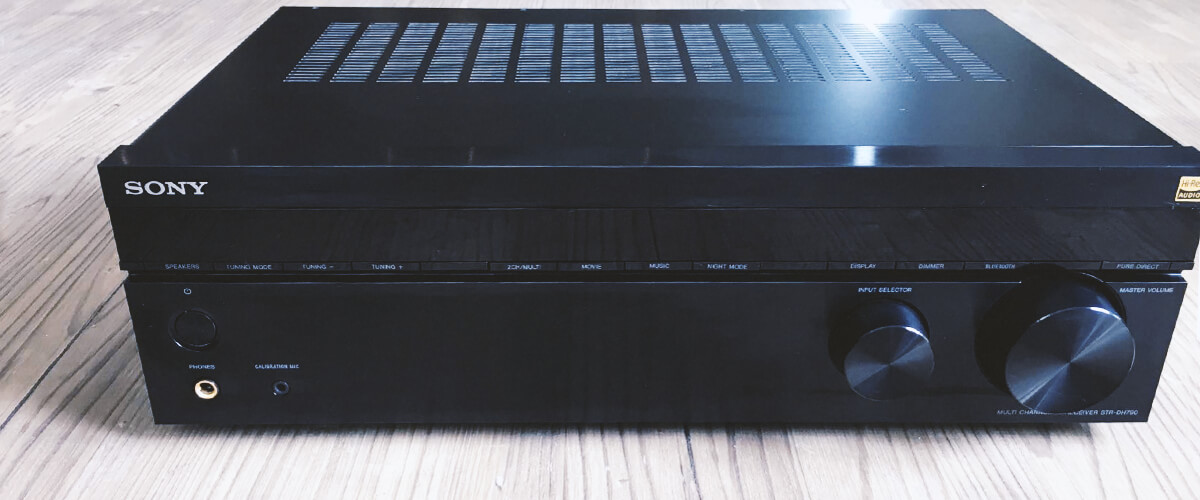
I really liked how Bluetooth works with streaming music. The sound is surprisingly good for an inexpensive receiver. But Sony clearly tried and compromised and left the main thing, namely the sound, at a high level. It’s definitely worth noting, though, that I just struggled with the setup regarding surround sound and the TV. I had to manually adapt each speaker because the calibration microphone didn’t do the job. And it took a long time. But in the end, the STR-DH790 performed very well in surround sound as well. I chose the movie Baby Driver because of the excellent soundtrack there, including the explosion, car racing, and dialogue. And the receiver showed good frequency separation, deep bass, and great power with balanced clarity.
The Sony STR-DH790 is the best budget 7.2 receiver, combining a good sound picture, stylish slim design, and modern features, albeit in a limited range. It will suit people who are willing to tinker with the setup to get great results at a nice price.
Key specs
- Channels: 7.2
- Power output: 90W/6 Ohm.
- HDMI inputs/outputs: 4/1.
- Video functions: 4K/60Hz.
- Bluetooth/Wi-Fi: yes/no.
- Streaming services: has not.
- Supports: HDMI ARC, HDMI eARC, HDMI CEC, HLG, HDCP 2.2, HDR10, Dolby Vision.
- Surround sound: DSD, Dolby Digital, Dolby Atmos, DTS HD Master, Dolby TrueHD.
Pros
- Wide compatibility with speakers from 6 to 16 ohms.
- S-Force PRO’s built-in virtual surround sound technology provides surround sound with two speakers.
- Decent sound quality at a very low price.
Cons
- Does not support 8K video.
- No Wi-Fi.
- Few HDMI ports.
- USB for power only.
- No phono stage.
- Difficult to set up.
Yamaha Aventage RX-A2A
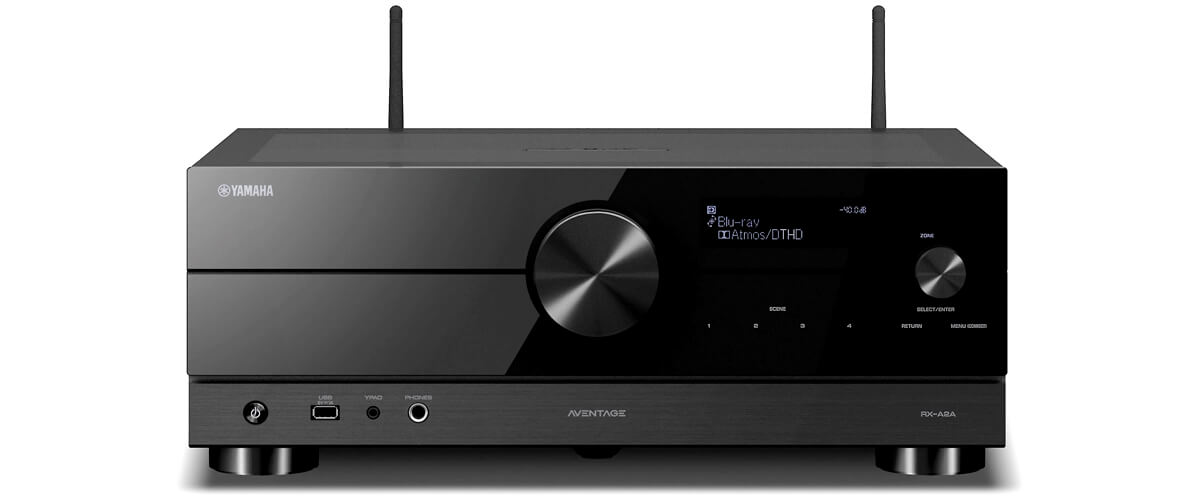
The Yamaha RX-A2A 2020 7-channel receiver is on par with the Denon AVR-X2800H and is only slightly inferior in features, literally in the nuances. Although its 100W power (8 Ohms, 20Hz-20kHz, 0.06%, 2ch) is slightly higher than the top of my selection, the THD is lower, providing cleaner sound. And that’s a plus.
It has 1 more HDMI port but one less output than the Denon. But they have the full capabilities of the X2800H (HDCP 2.3, eARC, 8K/60Hz support, and HDR10+, Dolby Vision, and HLG formats). Everything is more or less identical for the rest of the connectors, too, including the phono input and the second subwoofer. But, the Yamaha RX-A2A 2020’s upscaling feature suggests improving video quality to 4K, not 8 like Denon’s.
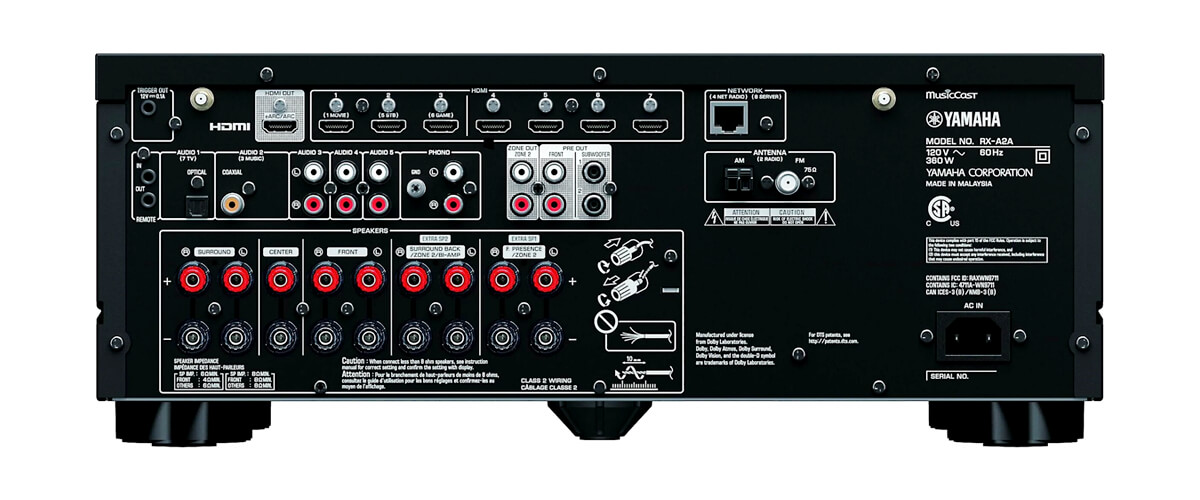
In terms of surround sound and wireless connectivity, you won’t find much difference either, except that there’s no Roon Tested compatibility. And instead of HEOS, Yamaha uses MusicCast as an ecosystem. And, of course, you can stream audio to 2 Zones.
The CINEMA DSP 3D technology for movies, music, games, and the Compressed Music Enhancer is unique to Yamaha. The former provides concert sound right in your home, while the latter enhances the quality of the compressed audio to the original.
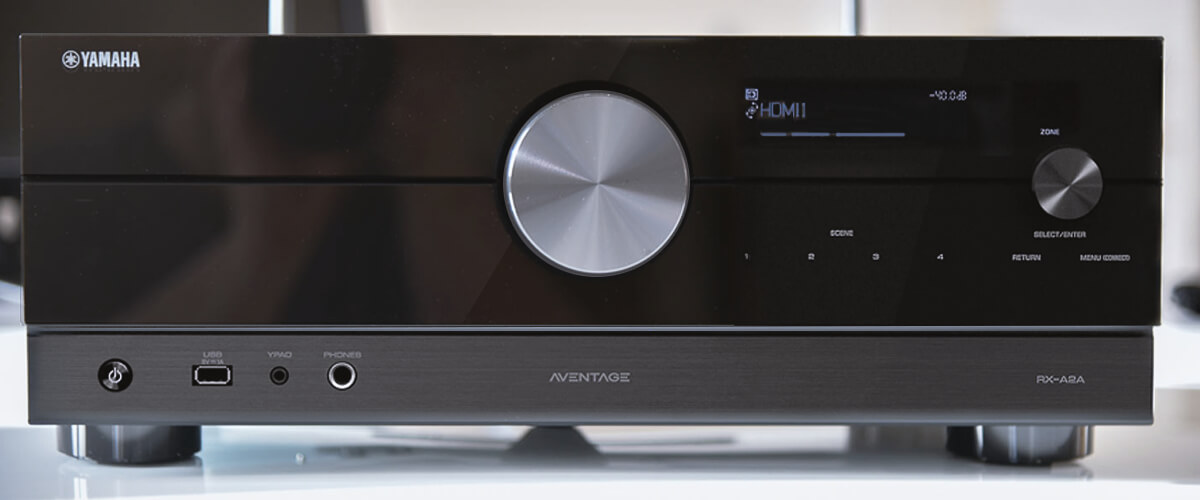
With the Yamaha, I always watch and listen to something with elements of the metal genre because it has a uniquely transparent, cool undertone. It makes it unique and different from other brands but sounds specific. Nevertheless, this company’s tech has a lot of fans, and I really like that crystallinity, too. So while watching King Arthur: Legend of the Sword, already in the first battle scene, I felt the benefits of this coolness when the swords in the hands of the knights were ringing. The bagpipes sounded distinct against the roaring phantasmagoric elephants, and the bass was rich and well-distributed. However, I noted some slight lag in the sound a few times.
When looking for the best 7.1 home theater receiver, check out the Yamaha RX-A2A. It may not be such a clear favorite, but this unit has a great sound spectrum, has all the modern options available, and looks stunning.
Key specs
- Channels: 7.2.
- Power output: 100W/8 Ohm.
- HDMI inputs/outputs: 7/1.
- Video functions: 8K/60Hz, 4K/120Hz pass-through, upscaling to 4K.
- Bluetooth/Wi-Fi: yes/yes.
- Streaming services: AirPlay 2, Spotify, TuneIn, Deezer, Tidal, Netflix, Amazon Prime.
- Supports: HDMI ARC, HDMI eARC, HDMI CEC, HDCP2.3, HDR10+, Dolby Vision.
- Surround sound: DTS:X, DTS Virtual:X, Dolby Atmos, Dolby Atmos Height Virtualization, Dolby Surround, Dolby Digital Plus, DTS HD Master, Dolby TrueHD.
Pros
- Lower THD than the other models in the selection.
- CINEMA DSP 3D technology brings concert sound to your home.
- Compressed Music Enhancer technology broadcasts compressed music formats how they should sound in the original.
Cons
- It does not scale video to 8K like similar models, but only to 4K.
- Rarely, but rarely, there is a problem with sound lag.
Onkyo TX-NR6100
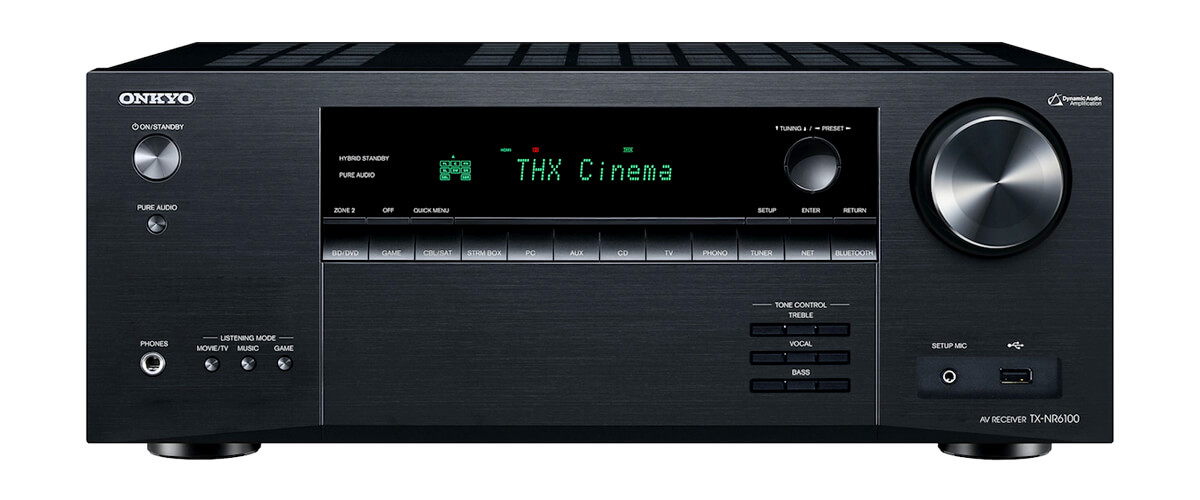
Last on my list of 7.2 receivers with pre-outs is the Onkyo TX-NR6100 2021 with 100W per channel (8 Ohm, 20Hz – 20kHz, 0.08% THD, 2 ch). And it is pretty similar to the Denon AVR-X2800H and Marantz SR5015, although cheaper than both.
There are no differences in video features, except for the version of HDMI ports (here they are 2.1 and 2.0, and upscaling is only possible up to 4K (like Yamaha RX-A2A). So I will not repeat myself. And in the area of surround sound, it only lacks Dolby Atmos and DTS: X virtualization.
In terms of wired and wireless connectivity, there are also almost no differences (except that it uses the Chromecast ecosystem built-in), so let me tell you about its unique highlights.
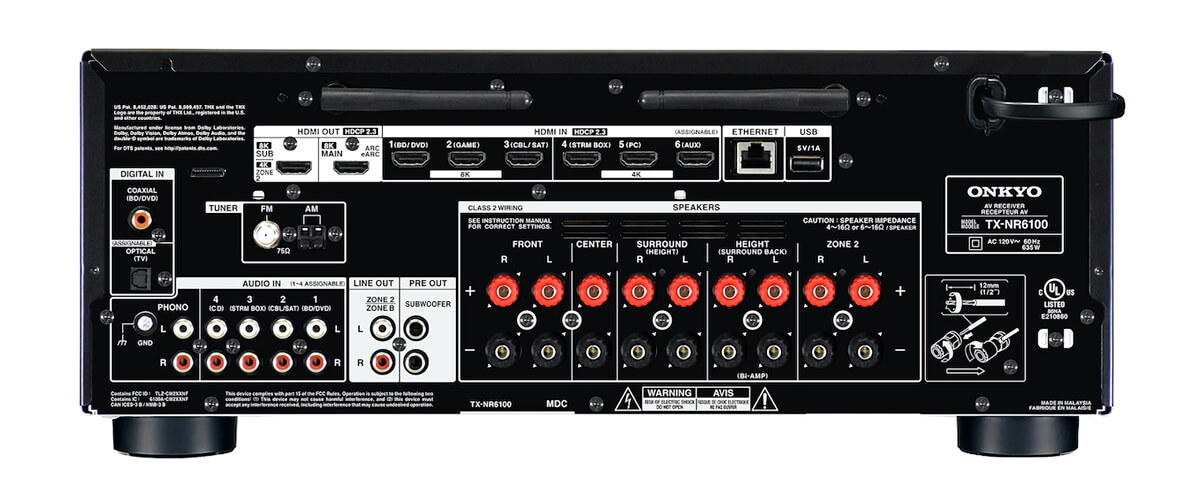
So, those include:
- THX CERTIFIED, which doesn’t allow you to change the original signal format.
- This receiver works with the Sonos home audio system, but the Sonos port must be purchased additionally.
- DTS Play-Fi allows each family member to use the receiver in different rooms.
- The only receiver on the list can both transmit and receive audio via Bluetooth wireless technology using SBC, aptX, or aptX HD codecs with maximum quality.
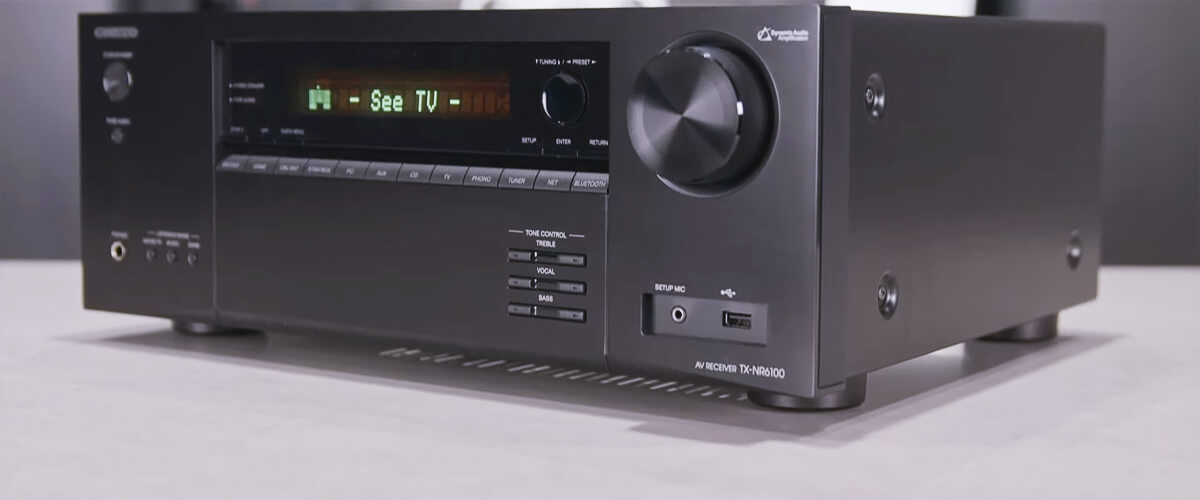
In testing, the Onkyo TX-NR6050 showed great results for its price. I really liked the way the dialog sounded in all the movies I watched, including content from Netflix and Blu-ray disc. Very nuanced, with minute details of breathing and the faults of the human voice. The overall soundscape was not mixed in dynamic scenes, as, for example, it might have been in Doctor Strange in the Multiverse of Madness, where there are a lot of sound effects, whether it be moving through universes or Wanda’s red lightning bolts. The sound was crisp and rich, with good midrange frequencies, and completely matched the picture. Overall, I was pleased with the level of quality. The only thing I didn’t like was the clunky interface.
Onkyo TX-NR6050 is an excellent alternative to more expensive models with unique advanced technologies. Its sound is excellent for its price and definitely deserves your attention.
Key specs
- Channels: 7.2.
- Power output: 100W/8 Ohm.
- HDMI inputs/outputs: 7/1.
- Video functions: 8K/60Hz, 4K/120Hz pass-through, upscaling to 8K.
- Bluetooth/Wi-Fi: yes/yes.
- Streaming services: AirPlay 2, Spotify, TuneIn, Deezer, Tidal, Netflix, Amazon Prime.
- Supports: HDMI ARC, HDMI eARC, HDMI CEC, HDCP2.3, HDR10+, Dolby Vision.
- Surround sound: DTS:X, DTS Virtual:X, DTS Neural:X, Dolby Atmos, Dolby Atmos Height Virtualization, Dolby Surround, Dolby Digital Plus, DTS HD Master, Dolby TrueHD.
Pros
- Functionally, it is very similar to the more expensive models.
- High-end THX CERTIFIED technology.
- Works with Sonos.
- DTS Play-Fi allows each family member to use the receiver in different rooms.
- Bidirectional Bluetooth technology transmits the signal in high quality.
Cons
- You have to buy a special port separately for Sonos, which is an additional expense.
- Clunky interface.
7-channel AVR buying guide
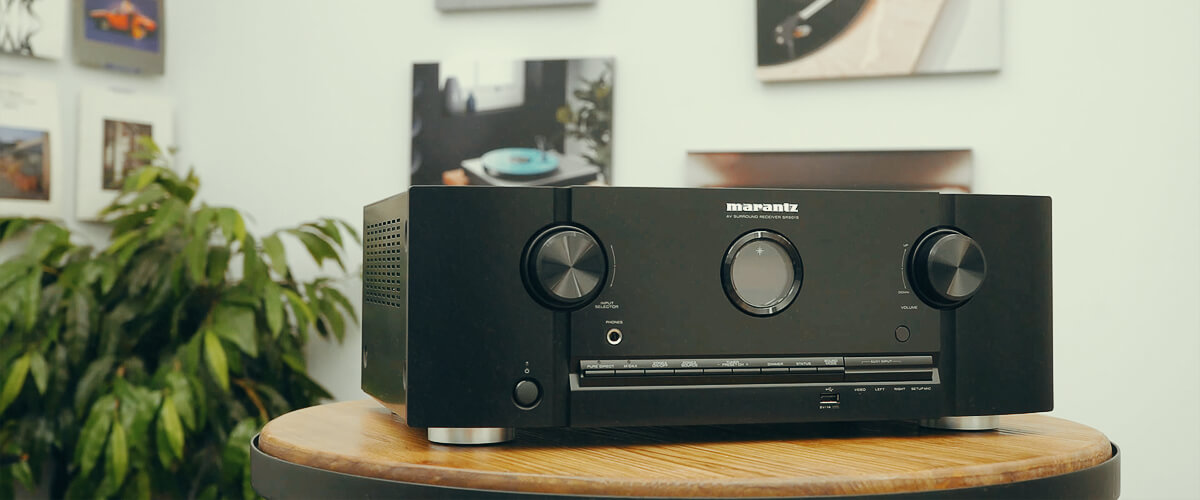
What connections do you need
When building a home theater system, the most important thing about a receiver is the number and variety of connections (connectors). Since 7-channel AVRs are inexpensive, they often don’t have enough ports to connect all your equipment, so you need to prioritize and decide in advance which devices should be connected at all times.
Component, coaxial (including digital), optical, analog, phono-in, and USB are designed to connect obsolete or specific equipment. For a standard modern system, you can sacrifice them in favor of more HDMI ports, which are the main ones today.
Pay attention to the HDMI version, and give preference to 2.1 because it has eARC, HDCP 2.3, and CEC functionality and supports the transmission of high-quality audio and video (8K resolution). A receiver with these features will last longer.
Receiver power: does it really matter
The standard power for 7-channel systems is 65-100W per channel, which is enough to evenly fill a room (300-400 square feet) with sound.
However, the more important parameter to pay attention to is THD. The lower it is, the clearer the sound at high volume. For example, a 75W/0.08% receiver will sound better than a 100W/1% receiver because a high THD will prevent you from using maximum power, producing noise and interference.
Built-in Wi-Fi, multiroom and streaming services
We live in a modern world, and you can’t have passed by such (now commonplace) things as Wi-Fi, Bluetooth, streaming services, voice assistants, and multi-room audio. For 7-channel receivers, these features are available but usually limited, so it’s important to pay attention.
Of course, barebones Wi-Fi and Bluetooth are the standard. Still, it’s important that they are built-in, or better yet, have advanced versions: aptX, SBC, or AAC codecs for Bluetooth or DTS Play-Fi, working with AirPlay and Chromecast in addition to Wi-Fi, as they enhance lossless signal broadcasting.
Multi-room audio can be provided by systems like HEOS, MusicCast, or even Sonos (but the devices must have compatibility and usually require the purchase of a special port). If streaming services and voice assistants are built-in, this also enhances the experience.
I recommend learning each technology and deciding if you need them that much because you usually have to pay more for extensive functionality in this area for the buyer.
Supported surround sound formats
Popular surround sound formats such as Dolby Atmos and DTS:X are available for 7-channel receivers, but this is the minimum configuration to work with them. Therefore, I would not really chase such options for the receiver, and more pay attention to their virtual versions (when you do not need to cut the speakers into the ceiling on purpose) or even standard Dolby TrueHD and DTS-HD Master Audio, which will quite satisfy the viewer with the quality of surround sound and make watching your favorite movie exciting.

